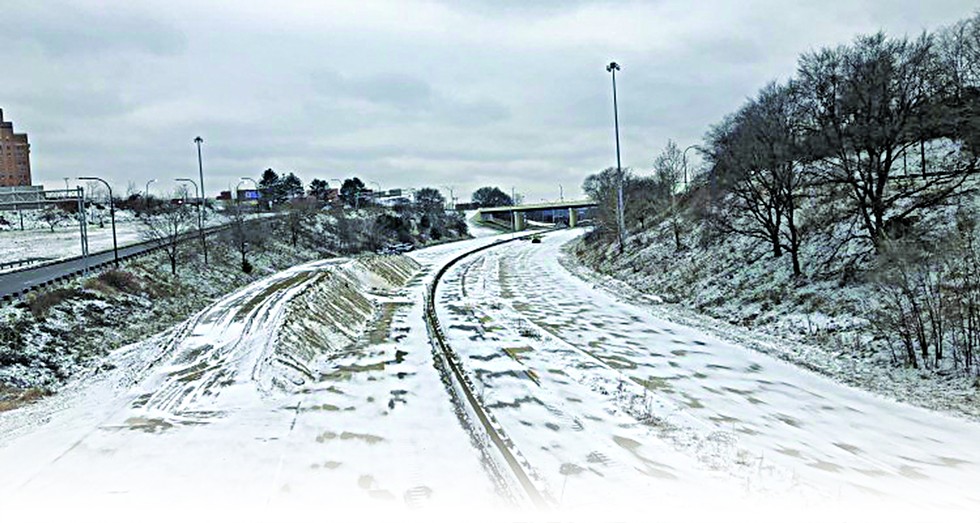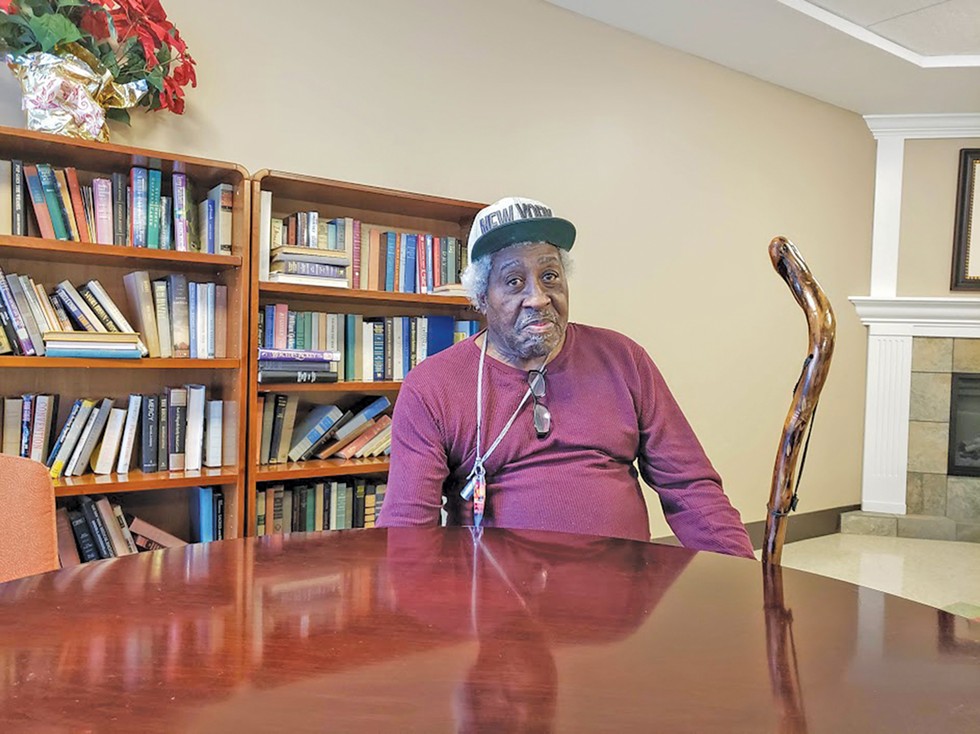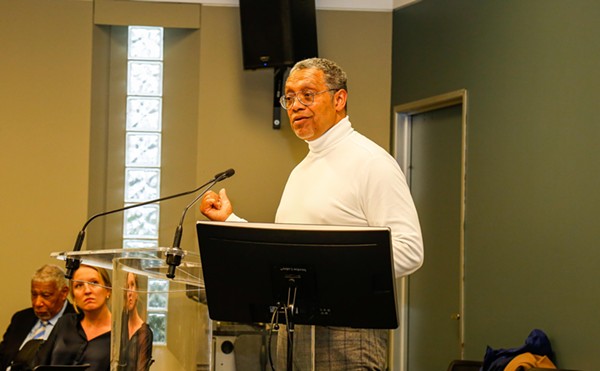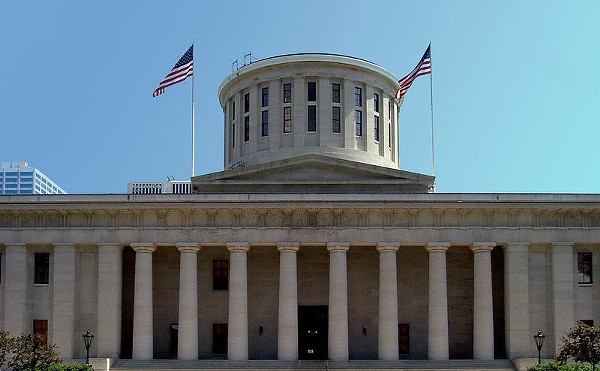Ollie Futch, 67, remembers his childhood fondly. Growing up just west of downtown Akron, his days were filled with wonder and adventure. From visiting the library on Wooster Avenue to playing basketball with his friends, his summers were endless. He still remembers his address — 733 Douglas Street. He and his mother, Sarah Futch, lived in an apartment, which Futch describes as nice.
But Futch and Sarah's old neighborhood, which was predominately black and low-income, was split in half by the construction of the Innerbelt Freeway in the 1970s. More than 100 local businesses were demolished. Thousands of people lost their homes and apartments and had to move elsewhere.
The vibrant streets of Futch's childhood were torn apart, literally, for a highway that was supposed to serve as a convenient way for people in the suburbs to better access downtown Akron. But the Innerbelt never did that successfully, and Akron is now tearing part of the Innerbelt down.
About 75 percent of the people displaced by the Innerbelt found themselves worse off than before or about the same, according to Akron's current director of planning and urban development, Jason Segedy. The remaining 25 percent were better off, either moving into newer neighborhoods or transitioning from renters to homeowners.
Around 1968, the City of Akron gave Sarah cash to help her and her family relocate. She bought a house at 1013 Moeller Avenue. Futch says Sarah transitioned well into her new neighborhood.
"I was glad for my momma. I guess she liked [the new house] because it was hers, more than anything. She owned it," he says. "And because of my momma's personality, she could build a community. She didn't care where she was living."
But not everyone was as lucky as Sarah.
After the construction of the Innerbelt, neighbors who were living 10 houses from each other suddenly had to travel miles to get around the freeway and get access to their neighbors.
Cynethia Patterson, 60, remembers how the neighborhood rapidly changed. She grew up at 521 Seth Court, which was demolished because of the Innerbelt.
"It took out a lot of businesses. It took out a lot of homes. It broke up the neighborhood," she says. "As kids, my mom would watch out for the neighbors, the neighbors would watch for us when our parents weren't home. It was more neighborly, more friendly, more family oriented."
To make matters worse, the Innerbelt didn't succeed as an infrastructure project, either. State Route 59 was meant to connect downtown Akron to the growing interstate highway system and bring traffic from the suburbs downtown more easily. The neighborhoods around downtown had become some of the city's poorest by the 1960s, and most people who worked office jobs downtown had fled to the suburbs.
Mayors Leo Berg and Edward Erickson conceived of the Innerbelt in the early 1960s, and it was built in four phases under Mayor John Ballard, who was in office from 1966 to 1980.
While it did connect to the interstate system, the Innerbelt never met its original goal of connecting to State Route 8 because the city ran out of federal funds. And even the stretch that currently connects to the interstate highway didn't bring in more traffic from the suburbs.
Figures from Segedy show that the Innerbelt cost about $300 million (from federal and local funds) and currently carries about 20,000 vehicles per day. For comparison, the stretch of I-76/I-77 in Akron carries 125,000 vehicles per day.
"On top of it being the wrong project at the wrong time for the health of the city and its neighborhood, it was never even finished," Segedy says. "It never even worked as a road. So we kind of got the worst of both worlds. We got lots of people displaced, the core of our city ripped, and then a road that never functioned as advertised."
'Continuing to break up our neighborhoods'
Wooster Avenue, today known as Vernon Odom Boulevard, was the heart of Malcolm Costa's neighborhood. His father, Jack W. Costa, owned Jack's Barber Shop at 562 Wooster Avenue. Costa grew up off Wooster Avenue and Lane Street, which was removed when the Innerbelt was built, and spent a lot of time exploring the business district.
"I was just a little kid. My dad would send me different places on Wooster Avenue to do errands and pick up lunch and different stuff. It was kind of like Coney Island. It was so vibrant and exciting," Costa says. "It was really thriving. It had all kinds of businesses. People could get pretty much everything that they might need in that area."
John Roberts, 85, also grew up in West Akron and agrees that Wooster Avenue had "anything on it that you needed."
"People back in the day depended upon each other. Back in the day, if my mother didn't have an egg or two or something she needed, and the neighbor had eggs, and maybe my mother had some flour and [the neighbor] didn't have any, they traded," he says. "That's how you survived."
During his time representing Ward 3 on City Council, from 1980 to 1983, Vernon Sykes called the Innerbelt "a road to nowhere."
Sykes grew up in West Akron and attended Samuel Lane Elementary School and South High School, which were both closed down in the early 1980s as people moved away.
"I think one of the main things (the Innerbelt) contributes to is continuing to break up our neighborhoods," says Sykes, who is now a state senator. "The high school that I went to, South High School, it's the second-oldest high school in the city, and it's decommissioned. That breaks up neighborhoods and the sense of community you need, that longevity you need, that helps build character and give people something to be proud of."
Many displaced people struggled financially after their relocation. James Williams, 74, grew up at 450½ Willow Street, another thoroughfare that became a dead end after the Innerbelt was built. He remembers many people losing their jobs because they couldn't make it to work.
"If you're living somewhere and you're working within footsteps to your job, and then when you have to leave to go somewhere else because you're forced to go, that's a big problem," Williams says. "A lot of them tried to walk. A lot of them had to take the bus."
The City of Akron negotiated with homeowners and renters and helped them relocate by giving them between $5,000 and $15,000. If you were a renter transitioning to owning a home, like Sarah Futch, you were given the most money, but if you were going to continue renting, you received far less. Families also received some money for moving expenses.
Tom Fuller, executive director of Alpha Phi Alpha Homes, Inc., was a social worker for the City of Akron from 1970 until 1972 and helped relocate many of the people who were affected. Fuller says that despite the city's financial help, many residents ended up worse off than before because they weren't prepared to become homeowners. They were receiving about a third of the value of the homes they were buying, and many were on fixed incomes.
"I remember one woman, after she had been relocated, six months later she called me and said her hot water tank had gone out. And she wondered what to do about it," Fuller says. "And there wasn't much additional financial help."
Fuller remembers that many of the affected people were initially excited about the opportunity to move out of the Wooster Avenue area. This is supported by a 1977 paper titled "Effects of Transportation Planning on Urban Areas" by University of Akron student Frank J. Kendrick, which was later published in The Ohio Journal of Science.
"Many residents whose homes are to be taken now look upon the impending relocation as a way out of a declining neighborhood. While many white residents of the affected neighborhoods may regard the Innerbelt as a threat to their homes, Black residents often consider relocation as a ticket to better neighborhoods," Kendrick wrote.
He continued, "Judging from earlier experience with relocation, this view may not be very well founded. Nonetheless, as the area declines, more and more residents continue to regard the state relocation program as a way of getting better homes in better areas."
Fuller says a large number of people were "anxious" about the relocation. Older residents, especially, were the least prepared to benefit, and were often the hardest to relocate.
"It was an emotional time for a lot of people. They were distraught sometimes. They were fearful of the unknown. The people we were working with, for the most part, had few resources. They were without power, without money," says Fuller. "And there was not the sensitivity about the impact on the community or the individuals so much."
Before the Innerbelt: Urban renewal and six days of rioting
Many of the homes that African-Americans resided in during the 1970s had been built quickly during the rubber industry boom in the early 1900s to accommodate factory workers. According to Dave Lieberth, a former deputy mayor and now an Akron historian, the city's population tripled in size between 1910 and 1920.
"It wasn't just dense housing, but really poorly planned housing, where you might have three houses sitting on one lot," Lieberth said.
James Williams' home, for example, was in complete disrepair by the 1970s. He remembers many of the homes in his neighborhood had "windows that were out, with newspapers over the windows." The basements flooded.
His house had three bedrooms and one bathroom. Williams grew up with 11 siblings.
"I didn't have a room. I slept on the floor. We had four beds. My mother and father had a bed and my two sisters had a bed. And then there were two more beds for the rest of us. So if you get lucky, you got the bed. We'd fight to get to the bed first. I slept on the floor many nights."
"Having a home and being in shelter is different," he adds.
A 1962 Mayor's Task Force on Human Relations paper says that almost 40 percent of Akron's 37,636 African-Americans were living in just four of the city's 24 tracts. Furthermore, "three of the tracts contain housing among the most dilapidated in the city."
According to the task force report, black families were concentrated in specific neighborhoods because "discriminatory practices are quite prevalent among real estate dealers in the Akron metropolitan area. Some were cited for refusing to show houses to non-whites in white neighborhoods, and for refusing to deal with non-whites altogether."
The task force added that, "a real estate dealer had been heard to boast that there would never be any Negroes in a particular area."
In the Akron neighborhoods that were predominately African-American, many homes were dilapidated. But black families could not move because they could not buy houses elsewhere. Further, families were unable to fix their homes because many could not apply for loans to fix them.
Today, Akron is attempting to renovate old buildings so they can be used again. But in the 1960s, the dominant trend in city planning was known as "urban renewal," which called for destroying dilapidated areas and rebuilding them from scratch.
"Urban renewal, as it should, gets a bad reputation. There was this idea that cities are declining because things were old, so what we need to do is tear down everything that's old," says Segedy.
According to Lieberth, urban renewal programs in Akron displaced about 3,000 households in the 1960s. About 80 percent of those households were African-American. If the average household was four people, then 12,000 people were displaced by urban renewal programs in a decade, including 10,000 African-Americans.
Before the Innerbelt was built, there were three major urban renewal projects that contributed to the large displacement of African-Americans in Akron: Lane/Wooster, Grant/Washington, and Opportunity Parkway.
The Innerbelt was a continuation of the urban renewal thinking, Lieberth says. City officials felt they were killing two birds with one stone: Renovating neighborhoods and providing an easier way for people in the suburbs to access downtown.
Further, if the city complied with national trends, they could secure federal funds.
"The federal government required us to have [the Innerbelt]. We had to take it if we wanted the money," Lieberth says. "The unintended consequences weren't seen. Everybody in power thought this was a good idea. There were people who protested, but they were powerless to stop them."
From 1991 to 1993, Tony O'Leary was the planning director for the City of Akron. He argues that a challenge for planning directors is deciding the difference between a trend and something that's permanent.
"You have to try to make decisions, but if the state or federal government decides they're going to put money in the freeways, you're going to go with it because you can't afford to pay for it locally," he says.
Urban renewal became prevalent nationally while the civil rights movement and the Vietnam War were underway. Suburbs were growing, but national transportation systems were still developing. Locally, Akron was facing major job losses in the declining rubber industry.
In the summer of 1968, the year marked by the assassination of Martin Luther King Jr. and nationwide protests, West Akron endured six days of rioting on Wooster Avenue. About 1,000 National Guard troops were sent to the city.
"I don't think anyone can be in denial that since the riots, everything changed," Roberts says. "I can take you around to the various streets when I was coming up as a child and show you the streets that have drastically changed so much."
The 1969 Akron Commission on Civil Disorder, which was asked by Mayor Ballard to determine the causes of the 1968 riots, blamed "the aggravated compression of Black people into Akron ghettos primarily as a consequence of the urban renewal programs in the Grant-Washington area, the area south of the University, and the downtown area."
After the riots, Costa's father sold his barbershop business. He was ready to retire and uncomfortable with hair trends at the time, but "I think part of the motivation for him selling the business was because of the social unrest," Costa remembers. "I think he was somewhat unnerved."
Costa now works as the director and CEO of Akron Summit Community Action, Inc., which addresses poverty in Akron through programs like Head Start. Costa and others in his neighborhood felt that the Innerbelt was a sort of penalty for the 1968 riots.
"I've never seen it documented, but I personally think constructing the Innerbelt in part was punishment to that community and making sure nothing like that would happen again," Costa says.
In 1970, before construction began on the second part of the Innerbelt, two alternate routes into downtown were proposed. One would have run along South Main Street, and the other around Perkins Park by the Kenmore Expressway interchange.
According to Akron Beacon Journal reports from that year, the alternate routes would have saved the more than 100 businesses that the Innerbelt later wiped out.
But city planners chose the original path, arguing that it was the route that could handle the most traffic. Using the alternate plans would've cost an estimated $300,000 in engineering fees and prolonged construction by three years.
Costa says that at least a dozen more streets were cut off when that phase of the Innerbelt was built, further dividing the community.
"You just can't access certain things, and you have to go around. There are only certain streets that go through, and it has the effect of being able to control that particular area in terms of law enforcement," Costa says.
Costa says Mayor Ballard may have intentionally harmed their community. But Lieberth says that's not true. After the 1969 commission report found that "the lack of good recreation and park facilities in the City of Akron has been recognized but comprehensive action to remedy this failure has not been undertaken," Ballard's administration spent close to $900,000 on recreation in the West Hill neighborhood, says Lieberth.
"It's really easy to say that this was all racially based. That was the impact of it, unfortunately, but personally, I don't think that city planners at the time, or anyone else in the state of Ohio, sat around and said, 'Let's see if we can screw up these neighborhoods,'" former planning director Tony O'Leary says. "That was just standard transportation planning."
After the Innerbelt: Green space? Housing? TBD.
The Innerbelt as we know it today was finished in 1987. Just 12 years after it opened, in 1999, Mayor Don Plusquellic started talking about removing at least part of it. He saw that Akron lacked vacant land for new development, and the Innerbelt had been built on what was once a neighborhood — land that could become a neighborhood again. At present, the last stretch of the Innerbelt has been closed, clearing up about 25 to 30 acres of land that the city must decide how to manage.
The argument for the rest of the Innerbelt's removal is twofold, Segedy says. First, it only carries about 20,000 cars a day, which Dart and Rand Avenues could easily absorb. Second, that land could be more useful as recreational space, offices or housing.
In the Downtown Akron Vision and Redevelopment Plan, created by the Downtown Akron Partnership and adopted by city council in March 2018, 82 percent of people surveyed said they wanted to see green space and trails on the space freed up by the Innerbelt. The plan envisions Route 59 as a "gateway to the [Cuyahoga Valley] National Park," with walking paths pointing visitors toward the Towpath Trail, Glendale Steps and Bates Hill.
As for buildings, the plan suggests developers start in vacant lots east of the Innerbelt, on the edge of downtown. It calls for "four-sided architecture that fronts each street," especially townhomes, condos and apartments. Only after that would anything be built in the sunken stretch where the freeway still sits.
"I don't personally really feel we need any of the Innerbelt," Segedy says. "We had the Cleveland Urban Design Collaborative, which is a collaborative of architects and students from Kent State University and Cleveland State University, look at it last year, and what they recommended was ultimately having some new buildings in the middle section of the part that was abandoned, and then on either end of it have green space and park land."
In 2015, the League of Creative Interventionists invited about 500 people to gather on the decommissioned section of the freeway for a meal. They asked residents what they wanted done with the space. According to the league, 80 percent of respondents said they wanted "a space for connection and nature."
In August and September of 2018, the League was awarded funding from the Knight Foundation's Knight Cities Grant to create a temporary park and performance space called the Innerbelt National Forest. Hundreds of Akronites gathered in the forest to see concerts and partake in community programming.
On Nov. 27, park organizers announced that the Innerbelt Forest space would become semi-permanent. Programming will resume in the spring.
There are no immediate plans to remove the remaining freeway, although Segedy argues that those hundreds of acres of land could become green space, housing and new buildings.
While the city is hoping to "crystallize a vision for the site over the next 18 months," Segedy says, it's imperative that officials continue to look back on the history of the freeway as they plan for the future.
"The value of studying history is restoring memory. And what's important for people to know is this is why we still have racial tensions," says Lieberth. "We haven't eliminated discrimination. We haven't eliminated the hard feelings that so many black families have, generations later."
This article was originally published in The Devil Strip. It is republished here with permission.














